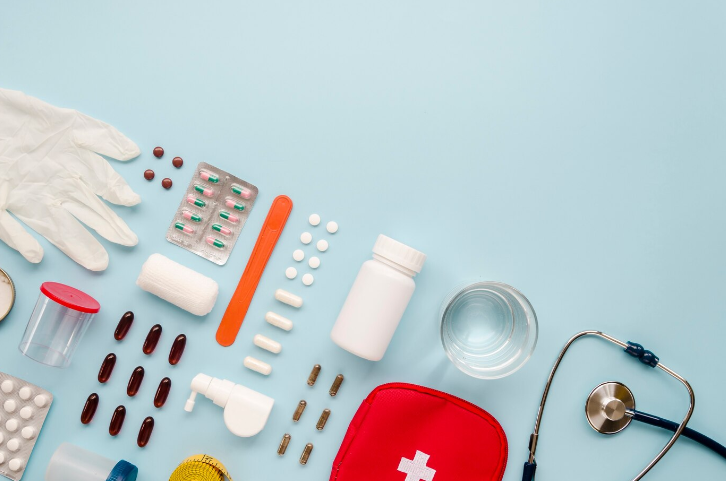Our Location
304 North Cardinal St.
Dorchester Center, MA 02124

Having a well-stocked home first aid kit is more than a matter of convenience; it’s a matter of health and safety. It ensures that you are equipped to handle minor injuries and emergencies promptly, potentially preventing further complications. From everyday cuts and burns to unexpected sprains or allergic reactions, a first aid kit is your first line of defense, providing you with the resources to administer immediate care.
Hi, I’m Alex, and let me tell you, I’ve been there—caught off guard by unexpected injuries at home with nothing but panic and a few random band-aids. After a particularly scary incident where my child got a nasty cut, I realized the importance of having a well-prepared first aid kit. Since then, I’ve made it my mission to ensure my home is equipped for any minor emergency. Today, I’m sharing my journey and insights to help you be prepared too.

Getting started with your first aid kit involves choosing a suitable container, ensuring it is well-organized and easily accessible, and including vital informational resources like emergency contact numbers and a first aid manual.
Selecting an appropriate container for your first aid kit is crucial. This container should be robust, easily accessible, and with sufficient capacity to house all the necessary supplies. A fantastic choice would be the Lightning X Products First Responder First Aid Kit. This kit offers ample room and multiple compartments, although it comes with a price tag of around $120. For those seeking a budget-friendly option, the “First Aid Only” All-Purpose First Aid Kit presents a portable and compact design for under $20.
Maintaining an organized first aid kit extends beyond merely having a well-structured container. Every item within the kit should have its designated place, allowing for instant access during emergencies. Bandages, for instance, can be categorized by size and stored in separate zip-lock bags. Medications can be neatly arranged into pill organizers, eliminating the need to scramble through a disorganized pile when time is of the essence.
A vital yet often overlooked component of your first aid kit is a list of emergency phone numbers, coupled with a comprehensive first aid manual. A highly recommended resource is the pocket guide from the American Red Cross, which can be indispensable in urgent situations. Having the numbers for essential services such as your family doctor, the nearest hospital, and poison control can be lifesaving under certain circumstances. Also, always include any relevant personal medical information, such as details about allergies or chronic illnesses. This information can be critical during an emergency.
By investing in a durable kit, categorizing items for ease of access, and preparing for emergencies with essential contacts and guidelines, you lay a strong foundation for a comprehensive and effective home first aid kit.
Common injuries like cuts, scrapes, and abrasions can be managed effectively with items from the first aid kit. Sterile gauze, adhesive bandages, and antiseptic wipes are crucial for cleaning these wounds, preventing infection, and promoting healing.
An instant cold pack from the kit can be used to minimize swelling and reduce pain associated with sprains and strains. Safety pins and adhesive tape can be useful to secure bandages or makeshift slings if needed.
Minor burns can be soothed with hydrocortisone cream. In some cases, sterile gauze can also be used to cover the burn area to protect it from further injury or infection.

An eye wash solution can be used to rinse out foreign substances from the eye, potentially preventing more serious damage.
For people with known allergies, the kit could contain antihistamines or even an EpiPen, if prescribed by a doctor. This could provide immediate relief in case of an allergic reaction.
Over-the-counter pain relievers can be used to manage pain or reduce fever temporarily before professional medical help can be sought.
While a home first aid kit can provide immediate care in these situations, it is essential to consult with a healthcare professional for any serious injuries or conditions. The purpose of the kit is to offer initial aid and to stabilize the patient until medical help arrives.

Ibuprofen, widely sold under the brand name Advil, is a type of non-steroidal anti-inflammatory drug (NSAID) that is highly effective in managing various types of pain, ranging from headaches, dental pain, menstrual cramps, and muscle aches to minor injuries. It works by blocking the production of certain natural substances in your body that cause inflammation, thus helping to reduce swelling, pain, or fever. A standard bottle containing around 200 tablets of Advil can typically be procured for between $10 and $15.
Acetaminophen, also known as Tylenol, is another indispensable over-the-counter medication for any home first aid kit. Unlike ibuprofen, it doesn’t reduce inflammation but is excellent at relieving mild to moderate pain from headaches, osteoarthritis, toothaches, and reducing fever. It achieves this by altering the way your body senses pain and cooling your body. Like ibuprofen, a bottle of Tylenol containing around 200 tablets is similarly priced between $10 and $15.
Lastly, for treating allergic reactions, nothing beats the efficiency of an antihistamine such as diphenhydramine, more commonly recognized as Benadryl. This medication is excellent for managing symptoms of allergies, the common cold, and hay fever. These symptoms may include rash, itching, watery eyes, runny nose, coughing, and sneezing. It works by blocking a certain natural substance (histamine) that your body produces during an allergic reaction. A pack of 100 capsules of Benadryl can be secured for approximately $10.
When it comes to prescription medications, the contents of your first aid kit should cater to the specific needs of its users. If someone in your household has a chronic condition, like asthma or heart disease, an extra inhaler or nitroglycerin tablets should be included. These are potentially lifesaving additions, but it’s crucial to regularly monitor their expiration dates. Costs for these items can vary depending on the specific medication and insurance coverage. A list of these medications along with dosage instructions should also be included in the kit, as this information can be invaluable during an emergency.

For keeping injuries clean and preventing infection, antiseptic wipes are indispensable. Brands such as First Aid Only provide wipes containing benzalkonium chloride, a powerful antiseptic, for around $10 for a box of 100. Hydrocortisone cream, like Cortizone-10 which costs about $7 for a 2 oz tube, is equally vital for soothing itchy or irritated skin, making it an essential addition to your first aid kit.
Eye injuries are surprisingly common, often resulting from everyday activities such as home renovations, gardening, cleaning, or even cooking. Simple incidents like a stray speck of dust, a splash of cleaning chemicals, or an accidental poke can cause significant discomfort or damage to the eye. For example, sawdust from a home renovation project might become lodged in the eye, causing irritation and redness. Similarly, accidental splashes of cleaning products could lead to chemical burns in the eye.
When it comes to treating these injuries using a home first aid kit, the first and most critical step is often to flush the eye with an eye wash solution to remove any foreign material or chemicals. Bausch + Lomb’s Advanced Eye Relief Eye Wash, which costs around $8 for a 4 oz bottle, is a reliable option. Rinsing the eye thoroughly mitigates the damage caused by foreign objects or chemicals. However, remember that any severe, persistent, or worsening symptoms should be promptly evaluated by a healthcare professional. First aid treatment is typically a temporary measure designed to offer immediate relief, but it does not replace the need for professional medical care.

In emergency situations, an instant cold pack and an emergency blanket can be crucial. An instant cold pack, like the Dynarex Instant Cold Pack costing around $10 for a pack of 24, can reduce swelling or pain from injuries, such as sprains or strains. Just squeeze the pack to activate the cooling effect, which can provide instant relief.
An emergency blanket, also known as a space blanket, retains body heat in cold temperatures and can be vital in shock management or when someone is suffering from hypothermia. The Swiss Safe Emergency Mylar Thermal Blankets provide a pack of four blankets for about $15, making them an affordable and space-efficient addition to your first aid kit. In addition to its primary function, this type of blanket can also be used as a ground cover or signal in outdoor emergencies, making it a versatile inclusion in any first aid kit.
Maintenance is key in ensuring your home first aid kit remains effective and ready for any emergency. A general rule of thumb is to check your first aid kit every six months. During these biannual reviews, you should inspect all items for expiry dates and possible damage. Antiseptic wipes, pain relievers, and prescription medications, in particular, need to be replaced before their expiration dates.
Additionally, after any significant use of the kit, immediate restocking is necessary to maintain readiness.
The cost of restocking will depend on what items were used but considering most first aid items are relatively inexpensive, the overall cost shouldn’t be too burdensome. A biannual review and replenishing can also serve as a great opportunity to re-familiarize everyone in the home with the kit’s contents and their uses.
A home first aid kit is much more than a box of bandages and antiseptic wipes. It’s an essential component of any household’s safety measures, equipped to handle minor injuries and stabilize more serious conditions until professional medical help arrives. A well-stocked, organized first aid kit can make the difference between a quick recovery and prolonged suffering, or in extreme cases, even life and death. Having a first aid kit is the first step, but knowing how to use it effectively is just as important. Continuous education on how to use the items in the kit and handle different emergency situations is crucial. Participate in local first aid courses or online tutorials to stay informed. Remember, a well-prepared home isn’t just about having the right supplies, it’s also about having the knowledge and readiness to use them when the need arises.